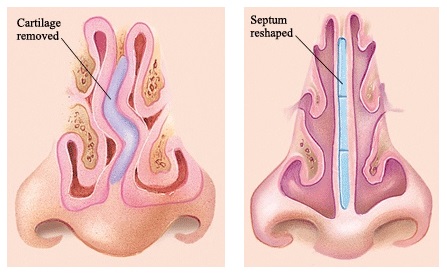A deviated nasal septum is a problem that happens when the cartilage in your nose is out of position, which can make your nose look a little strange and lead to nosebleeds, breathing problems and pain. A septoplasty is the procedure that aligns your septum again, allowing the air to flow more freely through your nose. The procedure is rather simple, so septoplasty recovery time is rather short.
How Long Does It Take to Recover from Septoplasty?
The detailed recovery time are listed below:
- Within several hours: Patients can go home because those who have a septoplasty usually undergo the procedure on an outpatient basis and the only thing holding them back is the anesthesia that must wear off in order to go home.
- From 7-10 days: Patients will be basically healed, but during this time patients should not travel, exercise, lift anything heavy, blow the nose, or do anything that might injure the nose.
- After 3 weeks: Patients can begin exercising and even go swimming if all bleeding has stopped.

However, there are other points to remember about septoplasty recovery time. No diving for two months, at least, and facial tanning is not a good idea for at least six months after the surgery. If you are in the sun, use a strong sunblock. Remember that the process of healing can seem to happen quickly, but it actually takes up to a year or more for the septum to return to where it is supposed to be.
How to Shorten Your Septoplasty Recovery Time
There are some ways to help speed up your recovery. These might work for most patients, so it is worth giving it a shot; at the very least, it will make you feel better.
1. Manage Swelling
Your face will definitely swell after the surgery. Using ice on the face can help relieve this. Frozen vegetables, such as bagged peas, are a great way to apply cold to the face. Remember not to use something too cold, as you don't want the added discomfort of being chilled.
2. Deal With Bleeding
Sometimes bleeding from the nose will be moderate during the first several days. The gauze protection, known as a mustache dressing, is designed to catch the blood and keep you more comfortable. The dressing can be changed when saturated, which might mean every hour during the first day. However, ice against the nose will also help with this problem. Always avoid aspirin or ibuprofen, as well as other drugs that are known to thin the blood, as you don't want to deal with the emergency of bleeding too much.
3. Home care
Home care is extremely important in shortening your septoplasty recovery time, so do following the suggestions below:
- When you get home, go to bed immediately and rest with your head elevated on several pillows. This helps lessen the swelling.
- Always have someone around during those first few days to help you move around; remember, you have lost a lot of blood, and you need time to become steady on your feet again.
- If you are constipated, do not strain at the toilet for it can make bleeding worse. Instead, ask your doctor for a stool softener or laxative.
- Finally, remember to avoid alcohol and tobacco, and stay away from secondhand smoke. Dust and fumes might irritate your nose and could even cause an infection.
- Wear contacts again only when the swelling has resolved.
4. Limit Physical Activities
You have just had surgery, so your physical activity should be curtailed accordingly. Septoplasty recovery time means no exercise for several weeks to promote healing, which means you have ot avoid any contact sports, running, lifting weights, and other intense exercise. Avoid anything that might spike your blood pressure.
5. Do Nasal Irrigation
Rinsing the nose is vitally important to promote healing and prevent infection. As soon as the packing is removed, use a saline nasal spray to prevent any crusting in the nose. Use the irrigation as long as directed, and be prepared to use it in the months to come, if you have a nosebleed, cold or other issue.
6. Lubricate Your Nose
Your doctor will direct you on how to use Vaseline on a Q-tip in order to soften crusts on the nose and promote healing. Peroxide can also help with the lubrication. Never try to remove the dissolvable surtures, and during septoplasty recovery time, they will come out on their own.
What Are the Potential Risks of Septoplasty?
Most people who undergo a septoplasty will recover easily with no complications. However, there are some cases where the septum will shift again over time, and lead to more breathing problems. In that case, an additional surgery might be needed.
There is always a risk when surgery is done, especially that of infection. Excessive bleeding, blood that needs to be drained from the nasal space, numb sensations of the face or teeth, and a decrease in the sense of smell have been reported. Other issues might include a septal perforation, a change in nose shape, and obstruction when breathing, even after the surgery is complete. Finally, those who are very sensitive to anesthesia might experience complications from the general anesthesia necessary for the procedure.
